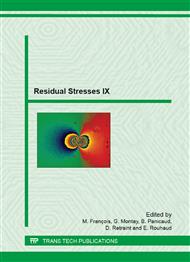[1]
G. S. Schajer and C. O. Ruud, Practical Residual Stress Measurement Methods, 1st ed., G. S. Schajer (Ed. ), Wiley, 2013, p.1–27.
DOI: 10.1002/9781118402832.ch1
Google Scholar
[2]
BSi 7910: Guide to methods for assessing the acceptability of flaws in metallic structures. BSi, (2005).
Google Scholar
[3]
R6: Assessment of the Inegrity of Structures Containing Defects, Revision 4, British Energy Generation Limited, R/H/R6, (2001).
Google Scholar
[4]
A. H. Mahmoudi, S. Hossain, C. E. Truman, D. J. Smith, and M. J. Pavier, A new procedure to measure near yield residual stresses using the deep hole drilling technique, Exp. Mech. 49 (2009) 595–604.
DOI: 10.1007/s11340-008-9164-y
Google Scholar
[5]
D. J. Smith, P. J. Bouchard, and D. George, Measurement and prediction of residual stresses in thick-section steel welds, J. Strain Anal. Eng. 35 (2000) 287–305.
DOI: 10.1243/0309324001514422
Google Scholar
[6]
T. -S. Jun and A. M. Korsunsky, Evaluation of residual stresses and strains using the eigenstrain reconstruction method, Int. J. Solids Struct. 47 (2010) 1678–1686.
DOI: 10.1016/j.ijsolstr.2010.03.002
Google Scholar
[7]
A. M. Korsunsky, Eigenstrain analysis of residual strains and stresses, J. Strain Anal. Eng. 44 (2009) 29–43.
Google Scholar
[8]
A. T. DeWald and M. R. Hill, Multi-axial contour method for mapping residual stresses in continuously processed bodies, Exp. Mech. 46 (2006) 473–490.
DOI: 10.1007/s11340-006-8446-5
Google Scholar
[9]
M. E. Kartal, C. D. M. Liljedahl, S. Gungor, L. Edwards, and M. E. Fitzpatrick, Determination of the profile of the complete residual stress tensor in a VPPA weld using the multi-axial contour method, Acta Mater. 56 (2008) 4417–4428.
DOI: 10.1016/j.actamat.2008.05.007
Google Scholar
[10]
A. M. Korsunsky, G. M. Regino, D. Latham, and J. Liu, D. Nowell, and M. Walsh, Eigenstrain analysis of synchrotron X-ray diffraction measurement of residual strains in machined nickel alloy plates, J. Strain Anal. Eng 41 (2006) 381–395.
DOI: 10.1243/03093247jsa135
Google Scholar
[11]
T. -S. Jun, A. M. Venter, and A. M. Korsunsky, Inverse eigenstrain analysis of the effect of non-uniform sample shape on the residual stress due to shot peening, Exp. Mech. 51 (2011) 165–174.
DOI: 10.1007/s11340-010-9346-2
Google Scholar
[12]
X. Song and A. M. Korsunsky, Fully two-dimensional discrete inverse eigenstrain analysis of residual stresses in a railway rail head, J. Appl. Mech. T. ASME 78 (2011) 031019.
DOI: 10.1115/1.4003364
Google Scholar
[13]
S. A. Faghidian, D. Goudar, G. H. Farrahi, and D. J. Smith, Measurement, analysis and reconstruction of residual stresses, J. Strain Anal. Eng. 47 (2012) 254–264.
DOI: 10.1177/0309324712441146
Google Scholar
[14]
G. H. Farrahi, S. A. Faghidian, and D. J. Smith, An inverse approach to determination of residual stresses induced by shot peening in round bars, Int. J. Mech. Sci. 51 (2009) 726–731.
DOI: 10.1016/j.ijmecsci.2009.08.004
Google Scholar
[15]
G. H. Farrahi, S. A. Faghidian, and D. J. Smith, An inverse method for reconstruction of the residual stress field in welded plates, J. Press. Vess. T. ASME 132 (2010) 612051.
DOI: 10.1115/1.4001268
Google Scholar
[16]
A. M. Korsunsky, G. M. Regino, and D. A. Nowell, Variational eigenstrain analysis of residual stresses in a welded plate, Int. J. Solids Struct. 44 (2007) 4574–4591.
DOI: 10.1016/j.ijsolstr.2006.11.037
Google Scholar
[17]
P. J. Bouchard, The NeT bead-on-plate benchmark for weld residual stress simulation, Int. J. Press. Vess. Pip. 86 (2009) 31–42.
DOI: 10.1016/j.ijpvp.2008.11.019
Google Scholar
[18]
H. E. Coules, D. J. Smith, K. Abburi Venkata, and C. E. Truman, A method for reconstruction of residual stress fields from measurements made in an incompatible region, Int. J. Solids Struct. 51 (2014) 1980-(1990).
DOI: 10.1016/j.ijsolstr.2014.02.008
Google Scholar


